Book contents
- Frontmatter
- Contents
- List of contributors
- Foreword by Robert M. May (Lord May of Oxford)
- Preface
- 1 Introduction: scaling biodiversity – what is the problem?
- PART I Spatial scaling of species richness and distribution
- PART II Alternative measures of biodiversity: taxonomy, phylogeny, and turnover
- PART III Scaling of biological diversity with energy and the latitudinal biodiversity gradient
- 11 Climate and diversity: the role of history
- 12 Inverse latitudinal gradients in species diversity
- 13 Regional-to-global patterns of biodiversity, and what they have to say about mechanisms
- 14 Recasting the species–energy hypothesis: the different roles of kinetic and potential energy in regulating biodiversity
- 15 Scaling species richness and distribution: uniting the species–area and species–energy relationships
- PART IV Processes, perspectives, and syntheses
- Index
- Plate section
- References
14 - Recasting the species–energy hypothesis: the different roles of kinetic and potential energy in regulating biodiversity
Published online by Cambridge University Press: 05 August 2012
- Frontmatter
- Contents
- List of contributors
- Foreword by Robert M. May (Lord May of Oxford)
- Preface
- 1 Introduction: scaling biodiversity – what is the problem?
- PART I Spatial scaling of species richness and distribution
- PART II Alternative measures of biodiversity: taxonomy, phylogeny, and turnover
- PART III Scaling of biological diversity with energy and the latitudinal biodiversity gradient
- 11 Climate and diversity: the role of history
- 12 Inverse latitudinal gradients in species diversity
- 13 Regional-to-global patterns of biodiversity, and what they have to say about mechanisms
- 14 Recasting the species–energy hypothesis: the different roles of kinetic and potential energy in regulating biodiversity
- 15 Scaling species richness and distribution: uniting the species–area and species–energy relationships
- PART IV Processes, perspectives, and syntheses
- Index
- Plate section
- References
Summary
Introduction
Understanding the causes and consequences of variation in biodiversity has long been a central focus of research in ecology and biogeography (von Humboldt, 1808; Hutchinson, 1959; MacArthur, 1969; Brown, 1981; Tilman, 1999; Hubbell, 2001; Clarke, this volume). Ecologists have been particularly fascinated by the latitudinal gradient of increasing biodiversity from the poles to the equator since at least the time of Darwin (1859) and Wallace (1878). Contemporary data indicate that this gradient holds for nearly all major groups of terrestrial, aquatic, and marine ectotherms, both plant and animal, and for endothermic birds and mammals (Rohde, 1992; Gaston, 2000; Allen, Brown & Gillooly, 2002; Willig, Kaufman & Stevens, 2003; Currie et al., 2004; Pautasso & Gaston, 2005; Clarke, this volume; Currie, this volume). Furthermore, fossil data indicate that this gradient has been maintained for over 200 million years (Stehli, Douglas & Newell, 1969). Despite more than 150 years of inquiry, the mechanisms responsible for the gradient are still not well understood (Allen, Brown & Gillooly, 2003; Hawkins et al., 2003; Huston et al., 2003; Storch, 2003; Currie et al., 2004; Clarke, this volume; Currie, this volume), but a large and growing list of hypotheses has been proposed to explain it (Rohde, 1992; Gaston, 2000; Hawkins et al., 2003; Currie et al., 2004).
In recent years, particular attention has focused on what we will refer to as the species–energy hypothesis, which proposes that the latitudinal biodiversity gradient has somehow been generated and maintained as a direct consequence of greater energy availability towards the equator.
- Type
- Chapter
- Information
- Scaling Biodiversity , pp. 283 - 299Publisher: Cambridge University PressPrint publication year: 2007
References
- 52
- Cited by



